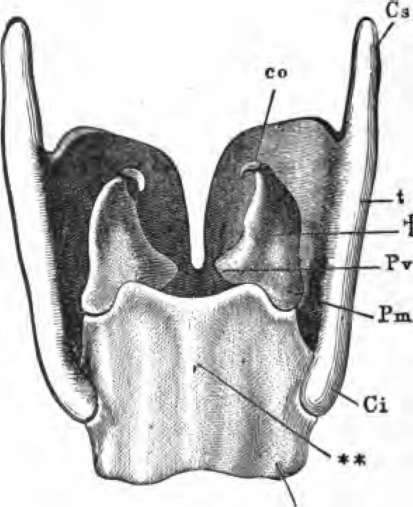The Human Larynx
Description
This section is from the book "The Human Body: An Elementary Text-Book Of Anatomy, Physiology, And Hygiene", by H. Newell Martin. Also available from Amazon: The Human Body.
The Human Larynx
The Larynx consists of a framework of nine cartilages, movably articulated together, and having muscles attached to them by whose contractions their relative positions are altered; the cartilages surround a tube, continuous below with the windpipe, and lined by mucous membrane. At one level in the laryngeal tube the vocal cords project and, pushing out the mucous membrane, leave for the passage of air only the narrow slit of the glottis, above mentioned.

Fig. 97. The more important cartilages of the larynx from behind. t, thyroid: Cs, its superior, and Ci, its inferior, horn of the right side; **, cricoid cartilage; †, arytenoid cartilage; Pv, the corner to which the posterior end of a vocal cord is attached; Pm, corner on which the muscles which approximate or separate the vocal cords are inserted; co, cartilage of Santorini.
Of what does the laryngeal framework consist? What do the cartilages of the larynx surround? How is the glottis formed?
The largest cartilage of the larynx (t, Fig. 97) is the thyroid. It is placed in front and consists of right and left halves which meet at an angle in front, but separate behind so as to enclose a V-shaped space. The front of the thyroid cartilage causes the prominence in the neck known as Adam's apple. The epiglottis, not represented in the figure, is attached to the top of the thyroid cartilage and overhangs the entry from pharynx to larynx. It may be seen, covered by mucous membrane, projecting at the root of the tongue, if that organ be pushed down, while the mouth is held open before a mirror. It is represented as seen from behind at a, Fig. 98. The cricoid cartilage (**, Fig. 97) has the form of a signet-ring, with its broad part turned towards the back of the throat, and placed in the lower part of the opening between the halves of the thyroid. The two arytenoid cartilages (†,Fig. 97) are placed on the top of the wide posterior part of the cricoid; each is pyramidal in form. The remaining laryngeal cartilages are of less importance.
Continue to:
